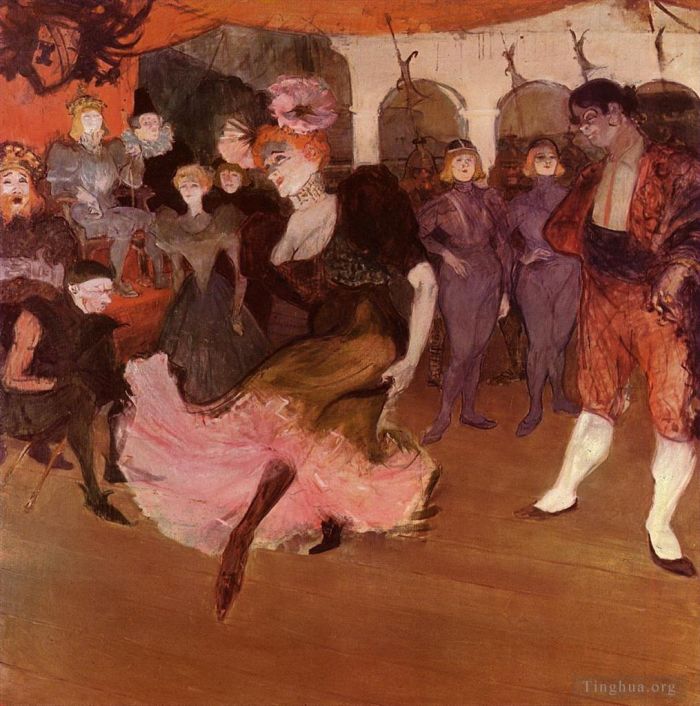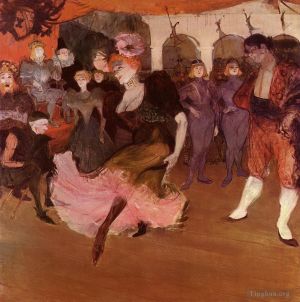Marcelle Lender Dancing the Bolero in Chilpéric
Henri de Toulouse-Lautrec
- Price: Price on Request
- Art Type: Various Paintings
- Size:
- English Comments: 0
- International Comments: 0
- Creating Date:
- Introduction and Works of Henri de Toulouse-Lautrec >>
Work Overview
- Marcelle Lender Dancing the Bolero in "Chilpéric"
Toulouse-Lautrec, Henri de
1895-1896
oil on canvas
overall: 145 x 149 cm (57 1/16 x 58 11/16 in.)
Henri de Toulouse-Lautrec had a passion for the theater in all its forms, from the popular dance halls and cabarets to the avant-garde theaters of Paris. He was both a keen spectator and an active participant, designing posters, theater programs, scenery, and costumes for a number of theaters and stage productions. Although he was drawn to the spectacle of the performance, it was the performers who most fascinated him.
Among Toulouse-Lautrec's favorite subjects was the red-headed actress Marcelle Lender. He first encountered her in 1893, the year he began to attend the theater on a regular basis. His infatuation with her reached its peak two years later when she starred in the revival of the French librettist and composer Hervé's Chilpéric. Performed at the Théâtre des Variétés in Paris from February 1 to May 1, 1895, this comic operetta recounted the tale of Chilpéric, king of the Franks in the late sixth century. In a bid to consolidate his power, he allied himself with the Visigoths in Spain through a marriage to the princess Galeswinthe, even as his vengeful mistress Frédégonde plotted her murder. It was neither the melodramatic narrative nor the extravagant staging of the operetta that most appealed to Toulouse-Lautrec, however, but the actress in the role of the princess. Like all his "furias" (as the artist termed his fixations on certain performers), this one was brief but intense. During the operetta's three-month run, he attended it more than twenty times, arriving just to see Lender dance the bolero in the second act. When asked about his devotion to the play, Toulouse-Lautrec explained, "I come strictly in order to see Lender's back. Look carefully; you will seldom see anything as wonderful. Lender's back is sumptuous." He sketched and studied the actress diligently, ultimately producing six lithographs inspired by her appearance in Chilpéric (five of them of the performance itself) and two paintings, including this monumental canvas. Toulouse-Lautrec's admiration was not reciprocated. "What a horrible man!," Lender is said to have remarked. "He is very fond of me….But as for the portrait you can have it!"
One of the largest and most elaborate paintings Toulouse-Lautrec ever created, Marcelle Lender Dancing the Bolero in "Chilpéric" depicts the very scene the artist so enjoyed, in which Galeswinthe performs the bolero, a lively dance from her native Spain, for her future husband and his courtiers. She dominates the center of the composition. Dressed in a Spanish-inspired costume composed of black and bright complementary shades of red and green, her body is described in strong, sinuous lines. Toulouse-Lautrec's portrayal of the actress is both dynamic and sensual. He captures her at mid-movement, as one long leg, clad in black stockings, juts boldly outward from a swirl of pink petticoats, mimicking the silk flowers she wears in her hair in form and color. Her low-cut bodice accentuates her ample bosom, which is tinged green from the reflected glow of the footlights. All eyes are upon her as she dances, from King Chilpéric, seated on his throne at left, to Galeswinthe's brother, Don Nervoso, who stands, arms akimbo, at the far right. Gazing at her from behind with an expression of open appreciation, it is Don Nervoso and not the viewer who is the beneficiary of the fine view of Lender's back, and as such he may be a stand-in for the artist himself.
- Copyright Statement:
All the reproduction of any forms about this work unauthorized by Singing Palette including images, texts and so on will be deemed to be violating the Copyright Laws.
To cite this webpage, please link back here.
- >> English Comments
- >> Chinese Comments
- >> French Comments
- >> German Comments
- >>Report
- The streetwalker
- At the Moulin Rouge the Two Waltzers
- Reclining nude 1897
- The spanish dancer 1888
- Prick and woodman 1882
- Jeanne Wenz
- Nice on the promenade des anglais 1880
- Count alphonse de toulouse lautrec driving a four horse hitch 1881
- Souvenir of auteuil 1881
- Woman in a chemise standing by a bed madame poupoule 1899
- Poupoule in chemise by her bed
- A Laborer at Celeyran
- The toilet ms fabre 1891
- Woman with an umbrella 1889
- Two friends 1895
- At the rat mort 1899
- Madame Lili Grenier
- The redhead with a white blouse 1888
- Woman at her toilette 1889
- Horse and rider with a little dog 1879
- Madame poupoule at her dressing table 1898
- Crouching woman with red hair 1897
- Dun a gordon setter belonging to comte alphonse de toulouse lautrec 1881
- Monsieur boileau 1893
- Margot
- Madame aline gibert 1887
- Artilleryman saddling his horse 1879
- At the races 1899
- Bust of a Nude Man
- Old Man at Celeyran
- Abandonment the pair 1895
- Woman at her toil 1896
- A Corner of the Moulin de la Galette
- Hangover aka The Drinker
- Babylon german by victor joze
- Yvette guilbert 1894
- The medical inspection
- Aristede Bruand at His Cabaret
- Prostitute the sphinx 1898
- The laundryman calling at the brothal 1894
- At the piano madame juliette pascal in the salon of the chateau de malrome 1896
- Cadieux 1893
- The singing lesson the teacher mlle dihau with mme faveraud 1898
- Moulin Rouge
- The jockey 1899
- Troupe de mlle elegantine affiche 1896
- Gustave Lucien Dennery
- Portrait of oscar wilde 1895
- The kiss 1893
- Prostitutes around a dinner table
- The haido 1893
- Louis pascal 1892
- Ambassadeurs aristide bruant in his cabaret 1892
- At the circus fernando the rider 1888
- The bed 1898
- The photagrapher sescau 1894
- Is it enough to want something passionately the good jockey 1895
- Queen of Joy
- May Belfort
- Jane avril dancing 1891
- They woman with a tub 1896
- Jane Avril
- Jane avril leaving the moulin rouge 1893
- Messaline 1901
- Little dog 1888
- Louis Pascal
- Alfred la guigne 1894
- Henri Gabriel Ibels
- The clown cha u kao 1895
- At the Moulin Rouge The Dance
- Booth of la goulue at the foire du trone the moorish dance 1895
- Napol on 1896
- La Goulue at the Moulin Rouge
- Cadieux
- Dancer Adjusting Her Tights
- The motograph 1898
- The clownesse cha u kao at the moulin rouge 1895
- La charrette anglaise the english dog cart 1897
- The promenoir the moulin rouge 1895
- Jane avril 1891
- Portrait of madame de gortzikolff 1893
- Marcelle Lender Dancing the Bolero in Chilpéric
- The coastal bus company 1888
- Coverage of the original print 1893
- La gitane the gypsy 1899
- The journal white poster 1896
- Hunting
- The actor henry samary 1889
- Two friends 1891
- At the circus dressage 1899
- Craftsman modern
- Divan japonais 1893
- A l elysee montmartre 1888
- In bed 1893
- Divan Japonais
- Seated dancer in pink tights 1890
- Messalina seated 1900
- Portrait of vincent van gogh 1887
- The procession of the raja 1895
- The mad cow
- They woman in bed profile getting up 1896
- Ball at the moulin de la galette 1889
- Tauromaquia
- Brothel on the rue des moulins rolande 1894
- Girl in a Fur Mademoiselle Jeanne Fontaine
- Madame misian nathanson 1897
- Jane avril 1893
- The last crunbs 1891
- Confetti 1894
- They cha u kao chinese clown seated 1896
- At the Cafe The Customer and the Anemic Cashier
- Red haired woman seated in the garden of m forest 1889
- The englishman at the moulin rouge 1892
- Helene vary 1889
- Woman pulling up her stockings 1894
- The grand tier 1897
- The cartwheel 1893
- At the circus horse and monkey dressage 1899
- At the opera ball 1893
- Lili Grenier in a Kimono
- In bed the kiss 1892
- The salon de la rue des moulins 1894
- Horsewoman 1899
- Comtesse 1887
- Indian decor 1894
- The box with the guilded mask 1893
- At the foot of the scaffold 1893
- At the nouveau cirque the dancer and five stuffed shirts 1891
- At the cirque fernando rider on a white horse 1888
- At the moulin rouge la goulue with her sister 1892
- Dancing at the moulin rouge 1897
- M delaporte at the jardin de paris 1893
- Nude standing before a mirror 1897
- The ambassadors people chics 1893
- Desire dehau reading a newspaper in the garden 1890









 Singing Palette
Singing Palette